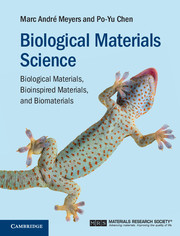Part III - Bioinspired materials and biomimetics
Published online by Cambridge University Press: 05 August 2014
Summary
Bioinspired materials and biomimetics
The ultimate goal for a materials engineer is to learn from the lessons of nature and to apply this knowledge to new materials and design. This is not a new quest, and humans have sought inspiration from nature since prehistory. The early materials used by humans were primarily natural: stones, bones, wood, skins, bark. The accelerating pace of the civilizing process has been attributed to the introduction of new synthetic materials; thus, the bronze and iron ages followed the stone age. We have now entered the brave new world of the silicon age, which is bound to produce unimaginable change. Homo silicensis, connected 24/7 to computerized contraptions, can already be seen on campuses and elite coffee houses, sipping lattes.
The constant quest for new materials and designs is leading us to a systematic inquiry of nature in order to unravel its secrets. This is the field of biomimetics, and VELCRO® is the standard example of bioinspired design. It is inspired by the burrs of plants that contain small hooks that attach themselves to animal wool or our clothes.
- Type
- Chapter
- Information
- Biological Materials ScienceBiological Materials, Bioinspired Materials, and Biomaterials, pp. 497 - 498Publisher: Cambridge University PressPrint publication year: 2014



